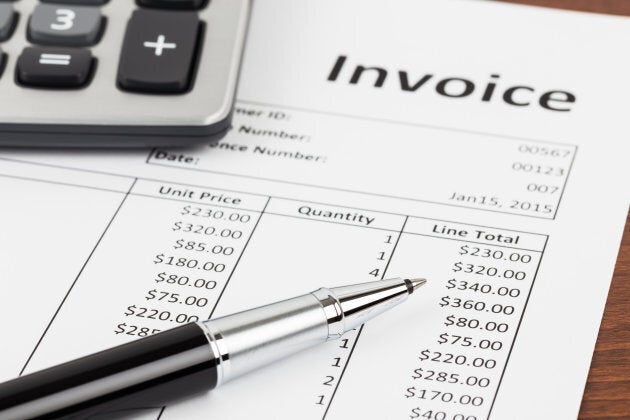
The traditional, permanent full-time job is dying a slow death in Canada, and precarious work in the new "gig economy" is taking its place. This story is part of Precariously Taxed, a HuffPost Canada series that looks at how gig economy and contract workers can optimize their finances when it comes to tax time.

Independent contractors, freelancers, and precarious workers — all of these names can be confusing when it comes to filing taxes in the gig economy.
But no matter what you call yourself, the main distinction that matters to Canada Revenue Agency is whether you're an employee of a company or if you're self-employed.
Earlier: CRA is coming for your undeclared tips. Story continues below.
Lisa Gittens, a senior tax professional at H&R Block, told HuffPost Canada there are a few questions to ask if you're trying to figure it out.
"Are you able to set your own hours? Are you able to set your own rate of pay? Are you able to determine where you conduct the work, where you do the task? And are you responsible for providing your own tools or your own equipment," she said.
"Self-employed falls into anybody who is a contractor, so you're hired by a larger company for a specific period of time to do a set task, or you are providing a service straight out of your home."
What you need to provide CRA
If you are self-employed, Gittens said it's important to make sure you have a receipt of services provided, or a contract drafted between you and the person or company you're providing services to.
"So if I'm providing services as a contractor to TD, there should be a contract that clearly states the day that my contract starts, when it ends, and what is my rate or base of pay."
"Is it based per client, is it based per item? I need something that clearly states that."

If you work on an on-call basis, like as a landscaper, you need to provide invoices to your client and to CRA that clearly state the date and cost of services provided, even if you haven't received payment for all of them.
"So in that year, the 10 invoices that I got paid for, that is the income that I can report. Now I'm going to show the 12 invoices that I issued, the 10 that I got paid for, and the remaining two are sitting in my debt to collect," Gittens said.
If you're a freelancer and you make more than $30,000 a year, you also need to register for a GST number within 30 days of the sale that puts you over that $30,000 mark. (You can call the CRA to set up a GST number). However, those returns can be filed annually or quarterly, and that schedule is determined when you register.
The biggest mistake is a form issue
Employees of a company receive a T4, which shows the deductions an employer has made on your behalf for the Canada Pension Plan, employment insurance, and income taxes.
But if you're self-employed, the question of what to use in place of a T4 becomes a little murkier.
Gittens said "one of the biggest mistakes" self-employed workers make is submitting the wrong form.
A contractor or self-employed person who provides services to a larger company may receive a T4A from them, which shows how much the contractor was paid. It may or may not have deductions for taxes, CPP, or EI. Taxi drivers, temporary workers who were paid by agencies, and some hairdressers and barbers would receive a T4A, Gittens said.
"If you were with a temp agency and they just paid you ... $1,000 because you showed up at a warehouse, you're good. No issues — because you didn't have any expenses," Gittens said.
More from HuffPost Canada:
However, if that person incurred expenses, such as having to buy equipment to do the job, they should be submitting a T2125 for their taxes instead of the T4A.
"But if you as a landscaper, you contracted your services, and in that $1,000 you had to provide your own tools, your own hand tools, you had to use your vehicle to get there to the job sites, now you have expenses, so you didn't really earn $1,000 to pay tax on."
"Chances are you earned more like $750. You need to claim those expenses."
A T2125 also has a different deadline. If you're filing a T4 or a T4A, you file by April 30. If you're filing a T2125, the deadline is June 17 for this year.
However, if you owe money to the CRA, it has to be paid by April 30 — no matter what form you're submitting.
You can't claim everything
Gittens said the CRA allows self-employed persons to deduct "reasonable expenses to earn income."
Expenses for keeping up appearances like manicures and haircut do not count, she said. Clothing can only be deducted as an expense if it's a specific uniform required for a business.
If you're paying rent and use a room in that space as a home office, a percentage of the square footage can be deducted. Desks and computers are also legitimate business expenses, she said. If you own your home, you can deduct property taxes, home insurance and some utilities. You can also deduct a portion of the interest costs of your mortgage, provided a part of your house is used only for business, or your house is your primary place of business.
If you purchased a cell phone for business, the full cost can be deducted. If you're also using it as a personal phone, you can pro-rate it and claim the business portion as an expense.
Correction:An earlier version of this article stated you cannot deduct mortgage interest costs. In fact, you can deduct a portion of mortgage interest costs if you meet the criteria set out by Canada Revenue Agency.